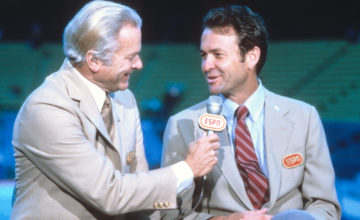[ad_1]
- ESPN Pioneer Beginning His 40th Year with Network
- “TV changed everything…(tennis has) transformed from a country club sport to a dynamic enterprise…a viable financial endeavor that is also filled with great athletes performing remarkable feats…It’s been an unbelievably great ride.”
Half a century ago, in the middle of Cliff Drysdale’s career, the sport of tennis underwent a transformative change, the dawn of the “Open Era.”
As of the summer of 1968, tennis would no longer be an amateur sport which shunned the barnstorming stars (including banning the likes of Rod Laver from the four Majors). They travelled around the U.S. and elsewhere and played for money while Drysdale and others played a circuit dominated by U.S. events (grass in the summer, indoors in the winter), plus tournaments in Europe and the Majors. There was no prize money. (For example, for reaching the Wimbledon semifinals in 1965 and ’66, Drysdale was rewarded with a gift certificate for two pairs of shorts from a fine London haberdashery. This year, the Gentlemen’s and Ladies’ semifinalists walked away with approximately $739,000.)
When the number of professionals doubled from eight to 16 in 1967, further diluting the fields for the Majors, Wimbledon took the plunge. The All England Lawn Tennis Club “opened” its gates to all players for the 1968 fortnight and the other Majors followed suit. In addition, tournaments throughout the year began to offer prize money…which led to television, sponsors and an explosion of exposure and popularity for the sport.
“TV changed everything,” recalls Drysdale, who affectionately is known as “Lord Drysdale” among the ESPN tennis team and was elected to the International Hall of Fame in 2013. “Lamar Hunt created the WCT (World Championship Tennis tour) and syndicated telecasts and the year-end finals did great ratings on NBC.”
Before this explosion, the sport was dominated by Americans, Australians and a few from Italy or Spain. Today, just look at the nationalities of the seeded players at the US Open. The sport has strong representation from Eastern Europe, Russia, Asia, South America and virtually every place in between.
For Drysdale, the changes he has seen in a lifetime in the sport are amazing, but have been beneficial.
“In some ways, the sport is unrecognizable, in terms of the show, the atmosphere and all that goes on around a tournament,” he reflects. “Now it is the most lucrative sport for women in the world. It’s transformed from a country club sport to a dynamic enterprise…a viable financial endeavor that is also filled with great athletes performing remarkable feats.”
Four Decades at ESPN (video of this story: https://es.pn/2LAIGgR)
As Cliff Drysdale’s career was winding down in the late 1970s (once ranked No. 4 in the world, he won the last of his 35 titles in Baltimore in 1978), he wondered what would fill the second chapter of his life. He recalls that time of his life:
“I’ve never planned anything in my life. I go with the flow. I had dabbled in television and got a call from a new outfit, ESPN in Connecticut. The first event was September 14, 1979, the U.S. vs. Argentina in Davis Cup from Memphis, Tenn. (Editor’s Note: That start date makes Cliff second in tenure to only Bob Ley who began five days earlier at ESPN, which had launched September 7.)
“One television executive told me cable ‘would not amount to a hill of beans.’ Good thing I didn’t pay heed to that advice!
“I never imagined I’d be here – working the Majors and major events, plus the long list of memorable Davis Cup adventures for 25 years. I didn’t know whether to get an office job with some company or just sit on the beach. For me, television fell in my lap and I have many people to thank. It’s been an unbelievably great ride.”
-30-
[ad_2]
Source link

